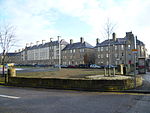Mountcastle, Edinburgh
Areas of EdinburghEdinburgh geography stubsUse British English from December 2017
Mountcastle is a suburb of Edinburgh, the capital of Scotland. It is east of the city centre and lies to the north-west of the neighbouring area of Portobello. Mountcastle is primarily a residential area, with many early-mid 20th century houses.
Excerpt from the Wikipedia article Mountcastle, Edinburgh (License: CC BY-SA 3.0, Authors).Mountcastle, Edinburgh
Mountcastle Drive North, City of Edinburgh Mountcastle
Geographical coordinates (GPS) Address Nearby Places Show on map
Geographical coordinates (GPS)
| Latitude | Longitude |
|---|---|
| N 55.951836111111 ° | E -3.1327111111111 ° |
Address
Mountcastle Drive North
Mountcastle Drive North
EH8 7SJ City of Edinburgh, Mountcastle
Scotland, United Kingdom
Open on Google Maps









